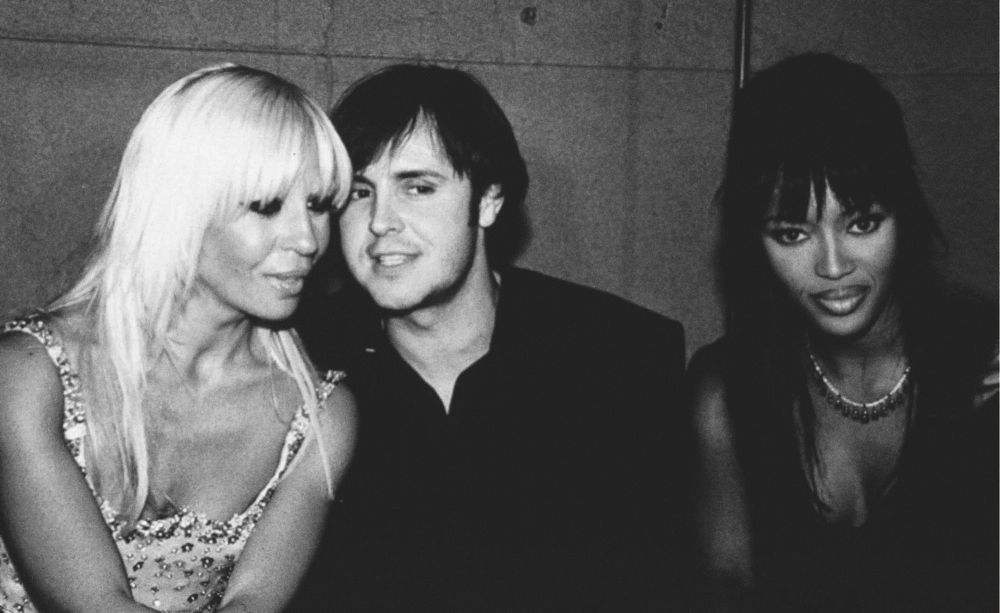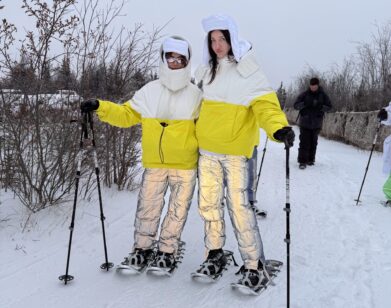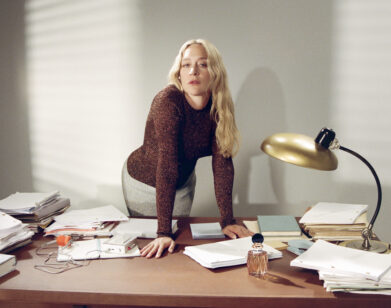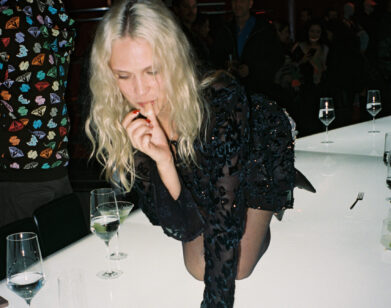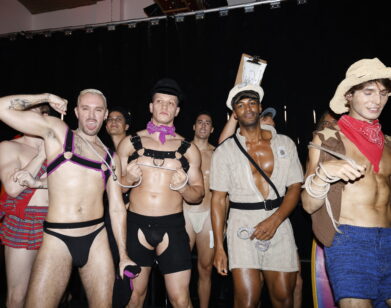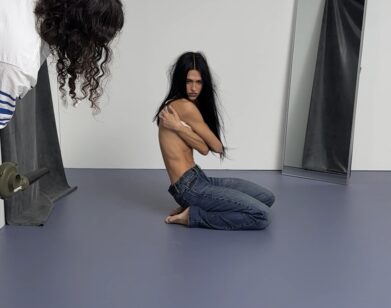François Nars
i aLwayS fELT LikE i couLd do makEup wiThouT So many producTS . . . ThE fun parT of doinG makEup iS rEaLLy mixinG ThinGS. François Nars
Beauty has been a lifelong obsession for François Nars. Even as a young boy growing up in Tarbes, in the South of France, he was an aesthete, developing an early—and avid—admiration for fashion magazines, Yves Saint Laurent, and his mother Claudette’s ever-growing collection of designer clothes. Later, as a student at the Carita makeup school in Paris, he began to experiment with the idiosyncratic plays on color and texture that he’d eventually use to upend the overly refined mode of beauty in the ’80s, when he got into doing looks for runway shows and on shoots for magazines like American and Italian Vogue, Harper’s Bazaar, and Elle—amassing a heavyweight list of collaborators that has included Richard Avedon, Steven Meisel, Helmut Newton, Irving Penn, Paolo Roversi, and Bruce Weber, as well as Marc Jacobs, Calvin Klein, and Madonna, among others, along the way. In the process, Nars has helped create some of the most indelible looks and fashion images of the past three decades. He has also been an innovator when it comes to the business of beauty, having launched his NARS line of makeup and skin-care products in 1994 with a collection of 12 lipsticks with names like Honolulu Honey (beigey-nude), Heat Wave (reddish-orange), and Jungle Red (a high-gloss glaze)—all packaged in matte black rubberized cases.
Descriptives such as “glam” and “smoky,” though, have little place in the NARS lexicon, where colors with names like Deep Throat and Sex Machine are the rule rather than the exception, and the pink-peach hybrid blush Orgasm remains a perennial best seller. Neither, it seems, do conventional ideas of beauty. As an artist, Nars has never sought to hide the imperfections and oddities that give faces their personality, but rather to accentuate them in dramatic and surprising ways, mixing and matching a minimal array of products to strike a delicate balance between nakedness and artifice—think bold, dark, painstakingly crafted eyes offset by clear, almost—bare skin.
Nars sold his company to Shiseido in 2000, buying a private island in French Polynesia with some of the proceeds. But he remains the essential driver of nearly every creative aspect of the NARS brand, and continues to collaborate on the design of the packaging, advertising, and stand-alone stores with Interview‘s editorial director, Fabien Baron, who has overseen the cool, streamlined look and feel of NARS since its inception. Nars also takes pictures and, since 1996, he has shot all of his own campaigns and put out two books of photography, X-Ray (1999) and Nars 15×15 (2009), as well as the beauty guides Makeup Your Mind (2001) and its updated version, Makeup Your Mind: Express Yourself (2011). Additionally, after a decade in self-imposed retirement, Nars returned to the runway in 2009, handling makeup duties for Jacobs, whom he first met more than 20 years ago on a shoot with Meisel during the designer’s short-lived tenure as creative director of Perry Ellis, and who remains his only show client.
Linda Evangelista, who has known Nars since the late ’80s—and has frequently served as a canvas for some of his most iconic work—recently met up with him at the Star Lounge at the Ritz-Carlton Hotel off Central Park in Manhattan.
LINDA EVANGELISTA: Do you remember when we first met?
FRANÇOIS NARS: I do remember. Do you?
EVANGELISTA: I don’t. I have no memory of anything anymore. People tell me things . . .
NARS: You’re not the only one.
EVANGELISTA: Naomi [Campbell] remembers everything.
NARS: Because she has a tape recorder inside of her.
EVANGELISTA: Yes, built in. It’s unbelievable. But there are so many things where I’m like, “No, I don’t remember that”—and they’re, like, big things . . . Actually, I remember the awful things about those early show days because I felt so out of place there.
NARS: During those early shows?
EVANGELISTA: Because initially, the rest of the girls were all “show” girls and I wasn’t. I didn’t have a place yet. I wasn’t a “print” girl or a “show” girl. I felt like I was the new one.
NARS: Well, I’ll refresh your memory. We met at the Calvin [Klein] show. You were doing Calvin—I think it was maybe one of the first times. I did your makeup, and I remember that I was not focusing enough at a certain point backstage and—
EVANGELISTA: Here it comes . . . [laughs]
NARS: I think I was re-powdering you, and Calvin was talking to me, and you said to me, “You’ve got to focus.” Then I remember the next day I was working with Steven and I said to him, “I worked with this girl, and she was heaven. I don’t know why, but I loved painting her and I loved the attitude. She was very pro—I turn my head, and I was not focusing, and she said, ‘Focus.’ There was something about her . . .” And he said, “Yeah, somebody from her agency told me I should see her.” So I was one of the ones who actually told Steven, “You have to see this girl. She’s definitely working.” [laughs] I remember like it was yesterday. I said to Steven, “You know, this girl was tough . . . But I kind of like that.”
EVANGELISTA: I apologize because I didn’t know that you could do powder without looking. [both laugh] But I do remember walking into Steven’s studio for that first shooting with Polly Mellen and you and Oribe.
NARS: I did everything I could so that you’d fall in love with the makeup and the hair.
EVANGELISTA: But there were so many girls booked on that shooting, and we were just sitting and waiting. Then I got my turn, and I got so insecure because you were all talking about my gums and my knees. I thought, “Oh, they don’t like me. There’s something wrong with my gums. They’re saying, ‘When she smiles, we can see her gums.’ ” And I’m like, I’m gonna get thrown out of here because of my knees.
NARS: But all those things were the things that made us fall in love with you.
EVANGELISTA: I thought you were critiquing. I thought I was gonna be thrown out for the knees and the gums.
NARS: And it was the beginning of a very long collaboration. I remember one time, when I lived on Broome Street, I was talking with Steven on the phone—I was upset about a boyfriend or whatever. I was so depressed. So Steven said to me, “Okay, we’re coming over.” So you all came over and did like a little runway show, and you were half naked with a fur coat . . .
haVinG a Look iS noT EnouGh… i fEEL Today, no maTTEr whaT, you don’T rEaLLy SEE GirLS ThaT you fEEL haVE ThE poTEnTiaL To STay and bEcomE rEaLLy iconic. François NarS
EVANGELISTA: Oh, god!
NARS: So you all came in and Steven said, “Okay, here is Elos [Evangelista’s nickname, coined by Carlyne Cerf de Dudzeele],” and then you walked in and opened the coat and you were naked underneath. And then Turly [Christy Turlington] came in and took off her coat and she was naked. Omi [Naomi Campbell], too. It was all to cheer me up.
EVANGELISTA: You know, I would never do that for anyone else. You know what a prude I am. I mean, I had to hold my hands over my boobs when you did my makeup. [both laugh]
NARS: I know. You would cover every inch of your body.
EVANGELISTA: I’m such a prude. I can’t help it.
NARS: Anyhow, so many girls—especially nowadays—are . . . Well, we can talk about that separately.
EVANGELISTA: I would love to hear what you think of the girls nowadays. Let’s talk about that now.
NARS: As soon as you tell people, “Oh, I loved this time . . .” they start saying, “You cannot be nostalgic.” Well, you know what? I’m very nostalgic—and I don’t care. [laughs] As much as there are good things today, talking about models now . . . You feel that they are really out there. But are they really enjoying being models? It’s very hard to say. I mean, I could always tell that you loved being a model. You loved being photographed.
EVANGELISTA: But how can you be good at something if you don’t like it?
NARS: Well, that’s why today, darling, girls disappear after a year. I mean, nobody lasts more than a year or two.
EVANGELISTA: Do they? No, that’s not true. There are so many.
NARS: Tell me who was the last one who lasted more than a year or two.
EVANGELISTA: Natalia [Vodianova].
NARS: Natalia. Tell me one picture you see of her now. Not much. You’ll see an ad with her . . .
EVANGELISTA: Or 20 pages in Vogue . . .
NARS: Okay, there’s one—thank god.
EVANGELISTA: And Raquel [Zimmermann].
NARS: Yeah, but she’s not always around.
EVANGELISTA: Because she takes breaks.
NARS: You didn’t take breaks at the time.
EVANGELISTA: We weren’t allowed. We didn’t take a minute off.
NARS: And that’s how I believe we became better and better—me for makeup; you in front of the camera. The more you work and the more you start being molded by the photographer- and by the hair, by the makeup, and discovering new angles, new makeup, and all that—that’s how you built up into being who you are today. But that, to me, is completely gone. I mean, which girl today do you see growing and transforming herself into an icon? There are not many.
EVANGELISTA: Karen Elson is an icon.
NARS: Yeah, but Karen is almost also part of . . . I don’t want to say the same era as we were, but right after.
EVANGELISTA: There’s this new girl, Cara, with the eyebrows.
NARS: What’s her name?
EVANGELISTA: Cara Delevingne.
NARS: Oh, yes.
EVANGELISTA: She’s all over the blogs, all over the Daily Mail.
NARS: Yes. She’s brand-new to me, so I can’t say. She’s got a look, yeah, but having a look is not enough. To me, that’s not necessarily a model. Before you, there were people like Veruschka. Those were models who will stay forever. I feel today, no matter what, you don’t really see girls that you feel have the potential to stay and become really iconic. I’m sorry, but that’s how I feel.
EVANGELISTA: I have one for you: Kate Upton.
NARS: Who’s that?
EVANGELISTA: The girl on the cover of Sports Illustrated. She’s everywhere.
NARS: I don’t know her. I have no idea who she is.
EVANGELISTA: You don’t know who she is?
NARS: I don’t know.
Guy bourdin waS onE of ThE phoToGraphErS who rEaLLy infLuEncEd mE To bEcomE a makEup arTiST, and i fELT ThaT hE dESErVEd To bE GiVEn crEdiT for ThaT.François Nars
EVANGELISTA: Do you still pay attention to all of the fashion magazines?
NARS: I keep an eye on all of them. There’s a little magazine stand at Hudson Street, and I go and flip. I must say I put back about 80 percent of the magazines that I look through, though.
EVANGELISTA: I buy less and less, too. I’m down to, like, four. They take up too much space.
NARS: I love the architecture magazines and all of the French magazines for decoration or whatever. I end up enjoying them more sometimes than the fashion magazines.
EVANGELISTA: When was the first time that you ever played with makeup? Did you get into mother’s makeup?
NARS: Yeah, I think probably on myself—I mean, like any queen, you know what I mean? [both laugh] Which queen didn’t play with makeup?
EVANGELISTA: How is your mother?
NARS: Mother is good. She looks amazing—still.
EVANGELISTA: She is so lovely and sweet. Does she still go to Tahiti?
NARS: She’s been to Tahiti with my dad many times, but now a little bit less in the last couple years. It’s a long trip.
EVANGELISTA: Do you go to the South of France?
NARS: Yes, of course. Still a lot. I stay at my parents’ house. I love going there in the summer.
EVANGELISTA: Why did you move to New York in the beginning? Did they not need makeup artists in the South of France?
NARS: I think I was tired of the South of France. I wanted to go somewhere else. The New York story is very easy: I was working on a job for American Vogue with Polly Mellen, and she was the person who said to me, “You have to come to the United States.”
EVANGELISTA: You were living in Paris at the time, right?
NARS: Yeah, but I’d done a couple shootings there for American Vogue, and the editor on them was Polly. I went crazy for Polly. I love Polly. She was so fabulous and such a character. She made me laugh and was also so incredibly talented. And she came from an era that was fascinating to me because she worked with Avedon in the ’60s and all that. So it was a dream. When she said, “You have to come to New York because I want you to work for the magazine there,” I said, “You don’t have to tell me twice—I’ll go and live in New York in a second.” So that’s the reason why I moved. I really wanted to work with those people, those legends.
EVANGELISTA: You got to work with some of them. Did you love working with Avedon?
NARS: I loved working with Avedon.
EVANGELISTA: Did you love working with him during the era when you worked with him, or did you wish you could’ve worked with him in another time?
NARS: I would’ve loved to have worked with him in the ’60s. I think the strength of the photographs of Dick in the ’50s through maybe the late ’60s were definitely superior to his work in the ’70s and the ’80s. Most of the biggest iconic photographs that Dick did were taken more in that ’60s period. That’s why, if I had to choose, I probably would love to work with him at that time. But Dick was a walking legend. It was like working with John Lennon or something.
EVANGELISTA: And how did you feel about your work with Mr. Penn?
NARS: Penn was the same thing. Even though Dick and Penn were both so different, they were both larger-than-life legends. Nobody is like that today. Nobody has that power or that impact in photography. The fabulous thing about them is they were photographers who did incredible fashion photographs, but then also did amazing work that had nothing to do with fashion, which is why they’ll remain forever in the world of photography. It was amazing to be around those people. Incredible personalities.
EVANGELISTA: Did you ever get a print from either Penn or Avedon?
NARS: Unfortunately, nothing from Penn. I almost got a print that I wanted to buy. It was a print from Worlds in a Small Room—you know, the project with tribes that he had photographed. I didn’t move forward, though, and I regret it so much now.
EVANGELISTA: But you know he gave away prints to so many people. NARS: Well, unfortunately never to me.
EVANGELISTA: Or me. [laughs]
i haVE a VEry Good SixTh SEnSE To know how To pick ThE pEopLE To work wiTh and coLLaboraTE wiTh. ThaT’S rEaLLy onE of my main TaLEnTS: ThaT i’VE aLwayS known whaT i’VE wanTEd. François Nars
NARS: Dick gave a lot of prints to Stephanie [Seymour Brant].
EVANGELISTA: I know. He loved Stephanie.
NARS: It actually ended up that Stephanie gave me one of her prints. [laughs] I have two prints of Stephanie from when we did Egoïste—one where she has a little monkey on her shoulder.
EVANGELISTA: Oh, I forgot about that Egoïste moment. Egoïste was a fabulous magazine, wasn’t it?
NARS: I loved Egoïste. I did a couple of issues for Egoïste.
EVANGELISTA: What do you think is the Egoïste of today? Is there one?
NARS: I don’t know . . . Not really.
EVANGELISTA: I think your book X-Ray is a little bit like Egoïste, in the freedom of it.
NARS: Maybe . . . I mean, the good part about X-Ray was the fact that it mixed together so many different people. So many people have asked me, “Why don’t you do a second X-Ray?” So now I’m supposed to do a second one, which I’m going to start in May. All of the people I could not get the first time—I’m gonna photograph them now.
EVANGELISTA: I think you should.
NARS: And I hope you’re going to be in it. [laughs]
EVANGELISTA: With you I could sit for hours and hours and hours, because I knew what you were doing, and you were painting and you were filling in and you were building. I mean, you used to create these lips that I didn’t have. You would go, “No, you can’t do it with a brush. The trick is the painting . . .” I had the patience to sit there because all the photos we did together didn’t really need to be heavily retouched. After you were done with me, that’s what I looked like. So many people rely on retouching now, though. Everything is postproduction.
NARS: Well, the only thing I can tell you is that I was obsessive. Today, it’s all about postproduction, though, which is a bit sad to me because I come from an era where there was not as much retouching. There were mirrors—we learned about mirrors. But a good photographer and a good makeup artist could not rely on retouching. It’s very funny because I was talking with Bruce Weber the other day, and he said to me, “Do you believe that everything is so computerized? I’m still shooting film; I never went to digital.”
EVANGELISTA: You can see that in his work. There’s a soul to it.
NARS: Yeah, and he’s still so passionate. He loves taking photographs.
EVANGELISTA: And you can see that—there’s always so much life in the images. But do you love working with postproduction in your own photography?
NARS: Of course, I love it then. [laughs] I mean, it’s like plastic surgery. The toughest thing is to not overdo it; same like you don’t overdo plastic surgery. It takes great talent to do good postproduction work. That’s why it’s so out of hand right now.
EVANGELISTA: When you work with a retoucher, do you talk to them and tell them what you want? Or do you sit there and guide them, direct them?
NARS: Oh, I’m right next to them. I tell them exactly the smallest details of what to do—even if it’s one hair of an eyebrow that I want moving this way. I’m the same as I am with makeup.
EVANGELISTA: So what’s your favorite thing to do now? Making makeup? Taking pictures? Working on your campaigns? Or do you love all of it?
NARS: I like all of it. They’re all so intrinsically connected at this point right now in my life. But I could not live without makeup. I still love creating makeup. What always amazes me, when I go to the department store and do a book signing or a public appearance, is that these the women who are so incredibly nice—some of them know the colors from 1994 when I launched the first 12 lipsticks. They remember every single color and they’ll go, “Please, can you bring back this color that got discontinued?”
EVANGELISTA: Do you like doing those kinds of things—appearances and whatnot?
NARS: I’m very shy so, of course, going to a store where there are 300 people waiting in line is a bit overwhelming. It’s not my favorite thing in the world. I like to be in the studio, playing with friends, in a small group. But the reward of seeing those women is very nice.
EVANGELISTA: When I see the way brands name their products now, I want to scream, because you were the first one to come up with these amazing names for your colors, which absolutely describe the color. That was your concept, and I feel like that’s part of what made your products so unique.
NARS: Other people have tried very hard, but I think I’ve still got the best names. There’s nothing you can do, so you have to take it as flattery.
EVANGELISTA: Well, it annoys me. [both laugh]
EVEn GrandmoThErS LikE orGaSm. François Nars
NARS: Of course it’s annoying. It’s getting so hard to find the good names after almost 20 years. I have this little agenda that I’m filling up 24 hours a day with names. So I’m working on it even when I sleep. Sometimes I wake up and write down a name in my agenda. Can you imagine?
EVANGELISTA: I know. Finding a name is easy. But matching it with a color . . . The colors are the names that you give them.
NARS: Because we have a sickness and we have to match it right away. [both laugh] That’s how it works.
EVANGELISTA: I loved the Warhol Collection that you did last year. It was so fun.
NARS: Well, get ready for the next one. It’s Guy Bourdin.
EVANGELISTA: Oh, my god.
NARS: It’s really crazy. Bourdin was one of the photographers who really influenced me to become a makeup artist, and I felt that he deserved to be given credit for that. We have purples and coppers . . . I mean, I knew the photographs so well that it was kind of easy to put the whole thing together. His son, Samuel, gave us access to all of the archives, so I was able to use the images as part of it.
EVANGELISTA: How did you get to Samuel?
NARS: Well, I knew Samuel from a while ago because I had done already one thing for NARS—one campaign—with Bourdin. So I contacted Samuel maybe eight years ago about that, and we always kept in touch. He said to me, “You can have anything you want.” I knew already so much of Bourdin’s work, but then he brought me even more pictures to see. I picked, I think, the most iconic one, which is the one I really loved as a kid. It was the one that really made me dream, the one that pushed me to be a makeup artist. It all goes back to when you’re a kid. But Bourdin was really one of the ones that got me here to where I am today.
EVANGELISTA: Do you own a Warhol?
NARS: I used to, but I sold it.
EVANGELISTA: Which one was it?
NARS: It was a Mick Jagger.
EVANGELISTA: Ooh . . .
NARS: Yeah. [laughs] A good one.
EVANGELISTA: What do you think my favorite lipstick is?
NARS: Honolulu Honey. And it remained in the line. It will never be discontinued.
EVANGELISTA: I can only do Honolulu Honey. [sings] Honey, where’d you get those eyes? [both laugh] I love my Honolulu Honey.
NARS: It’s still fun to do colors. I love that.
EVANGELISTA: How much money have you made off of Orgasm?
NARS: Probably millions. [laughs]
EVANGELISTA: Is that your biggest seller?
NARS: One of them.
EVANGELISTA: The blush?
NARS: The blush. The Multiple sticks are also a big seller. But I don’t even keep up on those things. They tell me because they like to tell me, but I never think about numbers or money.
EVANGELISTA: Did Orgasm buy you your Warhol?
NARS: [laughs] Probably.
EVANGELISTA: That’s the only blush I use. It looks good on everybody.
NARS: It’s a good one. But I designed this color like I would have designed any other color. I swear I never thought this was a special color.
EVANGELISTA: Not even in your subconscious?
NARS: No. You know, I create all these products and they’re like my children. Of course, sometimes you have a preference, but when it comes to the Orgasm blush, I really didn’t design it in a special way. I picked out the name like I would have picked out any other name.
EVANGELISTA: Well, it’s such an orgasmic color.
NARS: Even grandmothers like Orgasm.
EVANGELISTA: You know, I recently tried to buy my son a pink polo shirt, and he was like, “That’s a girl color.” But I kept telling him pink looks good on everybody. You’re the one who taught me that.
NARS: It’s very flattering.
EVANGELISTA: It looks good even on pink skin. I have a redheaded friend who looks beautiful in pink. But Orgasm isn’t exactly pink.
NARS: That’s the good part: we don’t know what color it is exactly. That’s why it’s so good. It’s not pink. It’s not peach. It’s not apricot.
EVANGELISTA: I know what color it is.
NARS: What color?
EVANGELISTA: It’s those colors you always mixed together to put on my face—the colors that you used on me. They were flat and matte, and then you’d add.
NARS: Yeah, I think I made it up like that. I always felt like I could do makeup without so many products. I felt like you don’t need a suitcase of 3,000 things, you know? That was a good part of mixing a lot. I’m always surprised at makeup artists arriving with a truck of makeup. It scares me. Makeup artists, in general, bring so many colors and so many products. I feel like some people work out of trucks. But the fun part of doing makeup is really mixing things—you know, mixing two colors to get another color. With basic colors you can really create 40 new colors.
EVANGELISTA: You don’t have a kazillion colors in your line.
NARS: Well, now it’s getting quite big. We create a lot of products. After almost 20 years, you also have to be sure that you don’t recreate something that you’ve done already.
EVANGELISTA: There’s always so much hype when you launch a new collection. The blogs go crazy. Does that freak you out?
NARS: It’s nice. We’re getting a lot of good response.
EVANGELISTA: How did you first meet Fabien?
NARS: You were actually there. I think it was on that shoot in Miami with Steven for Italian Vogue.
EVANGELISTA: That might be one of my favorite shoots that I’ve done.
NARS: The one with the Cuban girl. That was such an iconic story—one that everybody remembers.
EVANGELISTA: So when you started NARS, why did you go to Fabien to help create the brand and the campaigns?
NARS: I knew right away he was the one. I didn’t have second choice—it was Fabien or nobody.
EVANGELISTA: Because you knew that he’d get you?
NARS: It was an instinct that I had. I have a very good sixth sense to know how to pick the people to work with and collaborate with. That’s really one of my main talents: that I’ve always known what I’ve wanted.
EVANGELISTA: Do you think that becomes a dream come true?
NARS: To have your own makeup line?
EVANGELISTA: No, to get what you want to achieve.
NARS: Oh, yeah. Of course. I mean, if you want something very much . . .
EVANGELISTA: I just have so many great—and very blurry—memories of those days when we started working together.
NARS: Oh, me too—of that time. The fabulous thing is that I have so many videos. I never transferred them to digital. I need a professional to do it—somebody I can trust, who will not duplicate them or sell them or put them on the internet. You have to be so careful. That’s why I never went forward with transferring them. But there is such gold on those tapes.
EVANGELISTA: What format are they?
NARS: They’re from that little camera I used to use—tiny tapes, like cassettes . . . What were they called? V8? No, that’s a drink. [both laugh] Hi8? In any case, I’ve kept them buried in a box in a dry place. I know Steven is also dying to see them again.
EVANGELISTA: I think I might know someone who can do it. Speaking of video cameras, do you remember the video camera we bought together on the street?
NARS: Oh, my god. Of course I remember.
EVANGELISTA: That was so good. Me, you, and Oribe were walking down the street, and this guy jumps out and says, “Video cameras for sale! $200!” And we were like, “Oh, yeah!”
NARS: We didn’t think twice.
EVANGELISTA: For some reason I had $200 cash and you guys didn’t, but you were like, “Let’s get it.” So we buy it, and on the way to your house we’re discussing who gets it. I remember that you wanted it so badly, and I was like, “But I put the cash in,” and we were arguing over it, and Oribe wanted it. But then we opened it up and it was a brick! That’s how much video cameras weighed then. It was perfect.
NARS: The weight . . . He calculated so well.
EVANGELISTA: We were so naive. It was the late ’80s . . . country bumpkins. And here I thought I was buying a hot camera. And then you were like, “Oh, poor Elos. She’s out $200.” And I was like, “Me? Why do I have to be out?” I wanted you to split the money with me, because $200 was a lot of money at that time.
NARS: Still is today—especially for a brick.
LINDA EVANGELISTA IS A CANADIAN-BORN SUPERMODEL.

